The premise is simple: read one comic every day for the entire year. It seems like a simple task but there is no way that I read 365 comics last year, even if you count the individual issues in collections. So, this year, I am committing myself to this reading challenge, in the hope that I can broaden my reading habits and fully engage with my favorite hobby again.
The last few weeks have been hectic; busy, busy busy. My day job has been horrendous and I have been working on something else that I will get to in a minute. I think it’s about time I found a way to make my comics research pay (insert smiley face here).
As Halloween approached, I delved into some of my old horror comic favorites and finally got around to finishing Marvel’s Fear Itself. On November 9th, I gave a talk at a comic conference held by Comics Forum in partnership with Thought Bubble (one of the best UK comic conventions). My talk looked at Frankenstein adaptations, so some of the reading fit in perfectly within these two weeks. Next week (week 45) will be dedicated to the Frankenstein comics though, so come back then for some old school adaptations.
So, without further ado, how did I fare with the ending of Fear Itself?
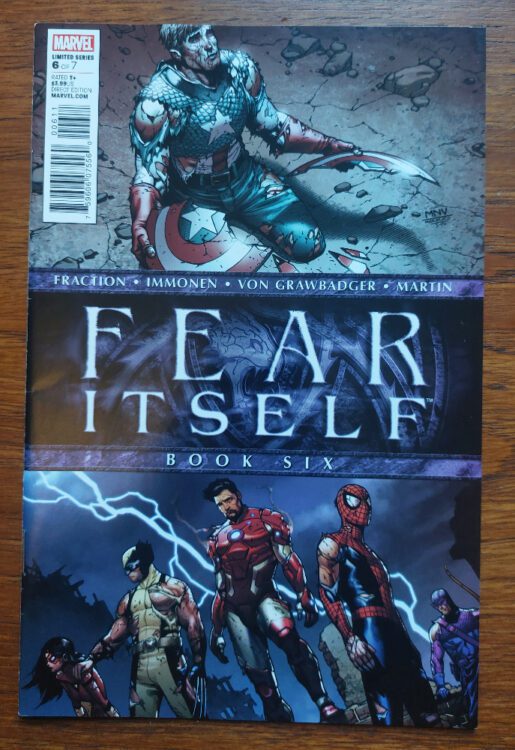
Credit: Marvel Comics
Comic Number 293: Fear Itself Book 6
It’s moody reconciliation time. This issue is packed with pep talks and magical weapons for all.
There is a touching two page moment where Spider-Man tracks down Aunt May in the destruction of New York; Thor and Odin have a father/son bonding moment; and, of course, Captain America makes a sterling speech about standing up to the enemy.
This is one of the better issues in the series, but it is still very fragmented: it’s all plot, no story. Due to the nature of the narrative, the events of the other comics have an impact on the central story, much more so than previous event stories, and this makes it difficult to read just the main title. The artwork is sufficiently apocalyptic and world shattering and the snippets of story that Matt Fraction includes are strong, emotional scenes for the characters involved in them.
Unfortunately, by this point, the good work that the creators are doing has to fight against a number of missteps in the previous issues and also the tie-ins. Like the heroes in Fear Itself, the readers and the creators seem to be fighting a losing battle, and are now just praying it all comes to an end.

Credit: Marvel Comics
Comic Number 294: Journey Into Mystery #628
The saving grace in the Fear Itself story! Kieron Gillen and the various artists who worked on this title since the Fear Itself story started were putting out one of the best Marvel comics at the time. Even with the forced link to the event story, Gillen was able to craft a beautiful, non-superhero comic that did all of the things that a good superhero comic should do. The central character, Kid Loki, is a superbly crafted character who easily carries this comic, but also is the star of the Fear Itself story line, even though he barely features in the main title.
I would still recommend this run of Journey Into Mystery to people and just tell them to ignore the fact it’s linked to the event story. You don’t need that in your life, but you do need this.
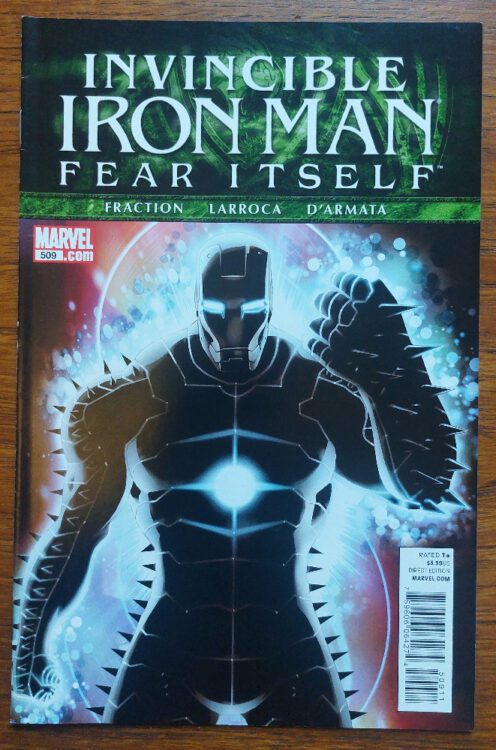
Credit: Marvel Comics
Comic Number 295: Invincible Iron Man #509
We already know where Tony Stark is going to end up, we’ve read Fear Itself Book 6, but — to be honest — this is probably the best tie-in issue of Invincible Iron Man since the story began. Stark has to face his demons, something that is handled in a surprisingly mature way, considering how a lot of this story has been presented so far. And, in contrast, Pepper is forced to face the consequences of her actions, setting up where the comic will go after the Fear Itself story-line comes to a close.
I actually enjoyed this issue more than I expected/remembered. But is it enough to read the rest of Matt Fraction’s run?
(dramatic pause)
I’m not sure yet. (Disappointing conclusion.. Speaking of which..)

Credit: Marvel Comics
Comic Number 295: Fear Itself Book 7
Somewhere near the beginning of this story, I’m sure there was a reference to a prophecy that Thor would defeat the Serpent, take seven steps, then fall. This kind of happens in the conclusion to Fear Itself, except not in a satisfactory way. For a start, Thor doesn’t take seven steps. It is implied he does, but how hard would it be to find a way to illustrate one of the central elements of the narrative? Seven, small inlaid panels, each indicating a foot step?
Of course, I may be wrong, I may be misremembering the prophecy, or missing some other point to the story. And that is my main problem with this conclusion. Because it has been such a long, difficult, ride to get to this point, the ending is unsatisfactory. The heroes beat the villains, obviously, no surprise there. But that’s kind of all that happens.
You can describe the comic as cinematic because it has that end-of-third-act feel from the Marvel Studios’ Avengers movies, where the spectacle of the fight is more important than anything else. Even Thor’s death isn’t an emotional sequence because you don’t have time to adjust from the fight scenes to the character work; it all washes into one.
And, finally, we get 16 pages setting up a number of other comic titles, none of which I bought so I can’t tell you if they are worth reading.
I went into my re-reading of Fear Itself quite excited for some high level superhero action but quickly realized that the lack of character hampered the main plot. I 100% believe this would be more enjoyable if I had all of the tie-ins, like I do with Civil War, but as a standalone series of seven comics, Fear Itself is disappointing.
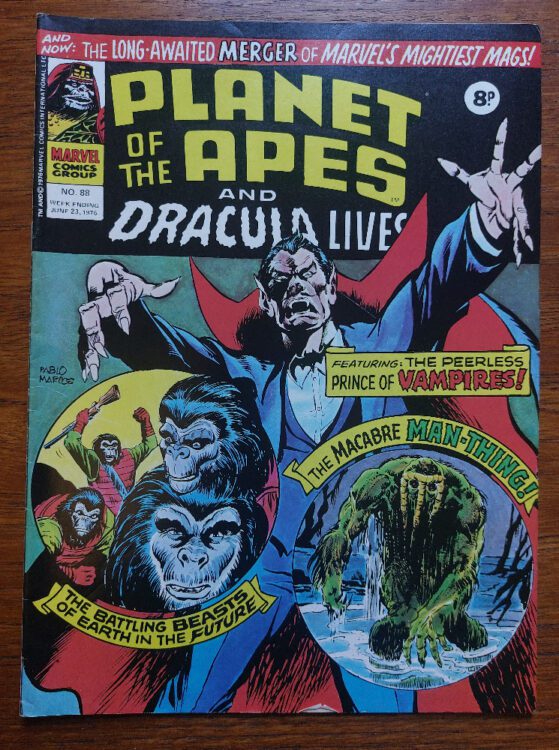
Credit: Marvel Comics
Comic Number 297: Planet of the Apes and Dracula Lives #88 (UK weekly comic)
And so the horror begins.
As a big fan of The Planet of the Apes (not convinced? Check out earlier posts here), I own a decent sized bundle of the old UK Ape weeklies from Marvel. In 1976, the comic merged with another of their weeklies, Dracula Lives, to form one of the best comics ever to grace newsprint.
Along with the Apes story, this issue includes part of a Man-Thing comic by Steve Gerber and Val Mayerik and, of course, Dracula himself. The story, “A Halloween Holocaust!!,” is a reprint from The Tomb of Dracula #41, and sees the vampire hunter Blade and friends confronting the lord of the undead in his home on Halloween night.
Written by Marv Wolfman and drawn by Gene Colan and Tom Palmer, the story is a classic Marvel confrontation issue. The heroes come face to face with the villain but circumstances stop them from killing each other. There are always circumstances. Meanwhile two children dressed as Spider-Man and a scarecrow witch come Trick or Treating. The ringing of the doorbell provides a distraction inside the mansion allowing the struggle to turn in favor of Blade. Although a cliche, this is a perfectly executed gag by Wolfman and the punchline spoken as the children walk away is charming. The Dracula series written by Wolfman combines all aspects of the Marvel comics in well crafted tales so that no one aspect takes over. It’s horror, comedy, and superhero comics all rolled into one.
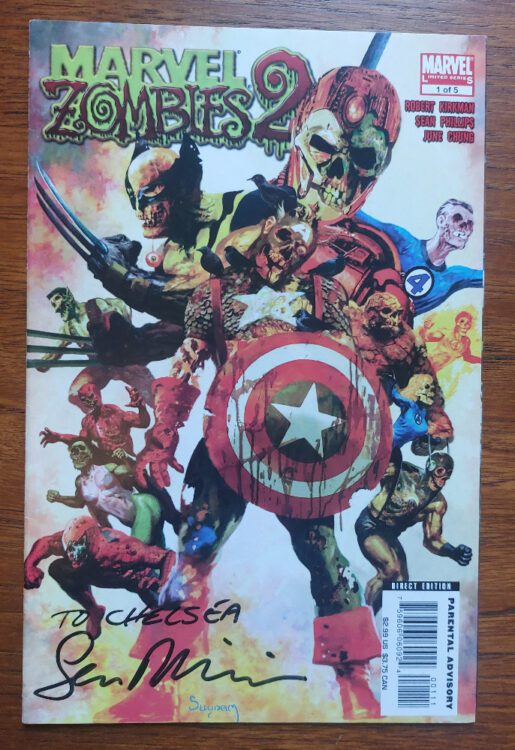
Credit: Marvel Comics
Comic Number 298: Marvel Zombies 2 #1-2
Written by Robert Kirkman, king of the zombies, and illustrated by Sean Phillips, artist extraordinaire, on paper this comic should be outstanding. The first Marvel Zombie series was fun, ridiculous, and entertaining. This is not.
It takes the stupidity of the Marvel Zombie concept and merges it with the monotonous, survival elements of The Walking Dead. The artwork is okay, with the cover art being infinitely more appealing but the story lets the whole thing down. It fails to bring the fun of cheesy zombie tales, and doesn’t connect with the more hard core survival stories. It falls between the gap of these two formats and, as a result, isn’t compelling enough for the reader. I had planned on reading the entire 5 issues but I stopped after issue 2.
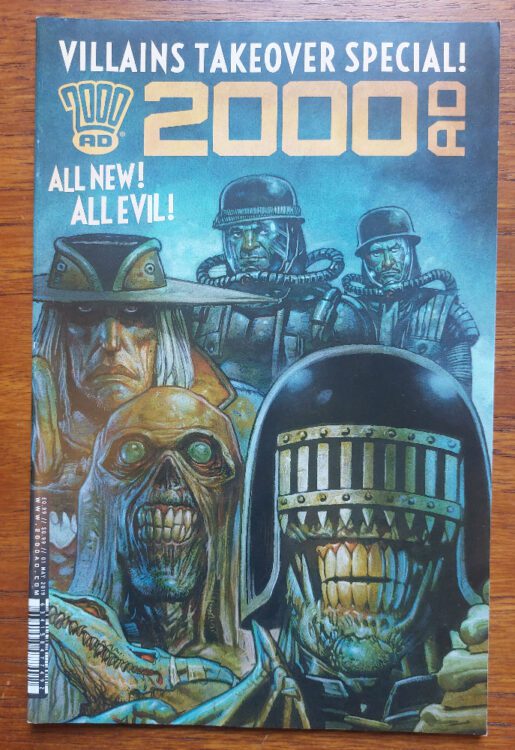
Credit: Rebellion Publishing
Comic Number 299: 2000AD Villain Takeover
This is a fun little comic focusing on the villains of the 2000AD world. Judge Death is there, mocking the DC universe with a story entitled The Judge Who Laughs, as is Slaine in another short, over-drawn adventure (there is so much going on in each panel it’s difficult to read). The weirdest tale is The Last of the Hellphibians. A ridiculous story by The Feek and Henry Flint with an amusing gag ending that feels like it should be more insulting than it is but they pull of the joke rather well.
Worth the 99 pence cover price, just for a laugh and a giggle.
And then we move straight into Week 44 with..
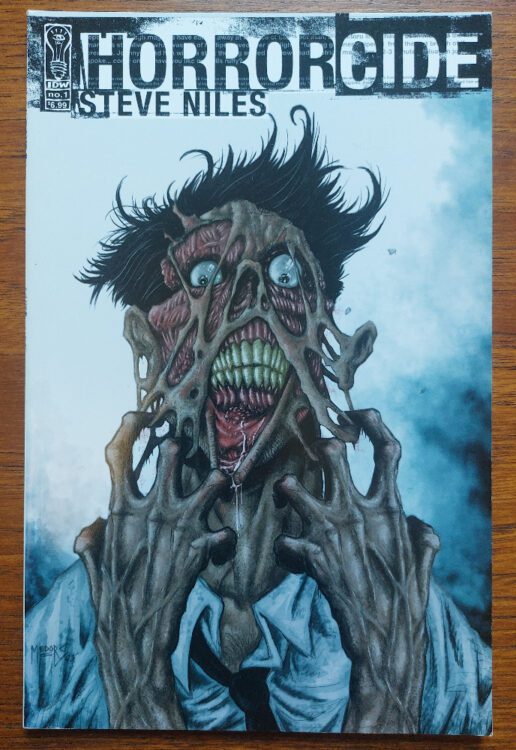
Credit: IDW
Comic Number 300: Horrorcide #1
A tasty little treat of short horror stories written by Steve Niles and illustrated by several different artists. This comic has a refreshing mix of stories with a couple of science fiction tales, a zombie revenge tale, and, the best of the bunch, a creepy killer next door narrative.
The final story, Neighborhood Creep with art by Ben Templesmith, is unnerving, creepy, and the perfect Halloween tale. It’s one to tell around a campfire on a dark night. Two boys challenge each other to take the shortcut home and venture near the creepy neighbors house. The yard is empty, the house inviting. Do the two kids dare to enter? The twist is brilliantly executed and the artwork atmospheric. A great way to start the week.
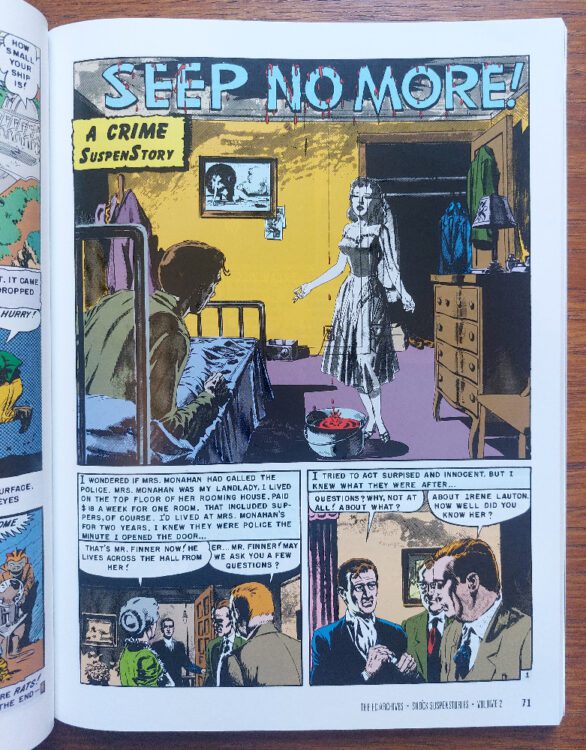
Published in Shock SuspenStories Vol 2 by Dark Horse Books
Comic Number 301: Seep No More (from Shock SuspenStories #8)
The first of many classic EC stories I’m reading this week. I’m picking certain stories to highlight, not full issues, but each EC story packs more in 7 or 8 pages than most modern comics.
In this modern retelling of Edgar Allan Poe’s The Tell Tale Heart, writers Bill Gaines and Al Feldstein change the setting to a more humble abode but crank up the gore. Artist George Evans creates a wonderful cast of expressive characters who, to be fair, tell the story without the heavy text captions but this is EC, this is how it was done.
A murder is committed and the guilt pushes the killer over the edge. As he tries to cover up the blood seeping through the ceiling, where he hid the body of his neighbor, his actions make him suspect number one. Will he manage to keep on top of the pools of blood dripping into his bedroom and avoid the nosy landlady or will the police detectives catch him in the act of cleaning up?
The twist will be obvious to today’s audiences, but it is also a classic. This version is well presented and the decent of the central character into madness is excellently portrayed through the artwork. Evans’ facial expressions really sell this story and make it worth reading, even though you know how it will end.

Credit: Fleetway Publishing
Comic Number 302: Revolver Horror Special
It’s Halloween! My favorite time of year and the perfect excuse to read horror comics (not that I need an excuse). There are many traditions surrounding Halloween: carving pumpkins, trick and treating, reading Revolvers Halloween Special. You don’t do the last one? You should. You really should.
Revolver was a short-lived, British anthology comic published by the 2000AD comics group. It was a sister comic to Crisis, and contained a host of experimental new comics. The Halloween special is no exception. Each story is different in style and pacing but they are linked by the horror element that sits at the center of each one.
I’m not going to go through the stories contained in this 80+ page special, you need to try and source this comic so you can discover them for yourself, but I will drop some of the names involved in this 1990 publication:
David Hine, Shaky Kane, Annie Parkhouse, Mark Buckingham, Garth Ennis, Mark Millar, and Neil Gaiman, to name some that you may recognize. It is the home of great British creators, producing some of their most interesting work because there were very little constraints put on them from the editors and publishers.
Revolver remains one of my favorite comics and this Halloween special is one that I never tire of reading. I’m going to request that I be buried with it so that I have something good to read when I return from the grave each year and hang around a in graveyard…
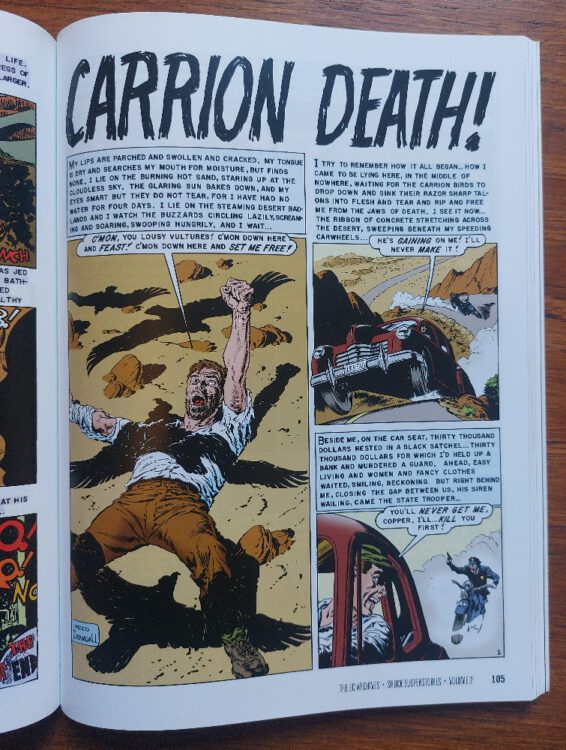
Published in Shock SuspenStories Vol 2 by Dark Horse Books
Comic Number 303: Carrion Death (from Shock SuspenStories #9)
A man tells the reader his story of being handcuffed to a dead body and trapped in the burning desert. The vultures are circling and it’s only a matter of time before he becomes their next meal. How does he escape to tell his tale? You must know the story by now, you know how EC works, and this is one of the more famous stories, featuring in the television series as well as numerous reprints.
The artwork by Reed Crandell is scratchy and grotesque. The central character has a constant expression of fear on his face and it’s just seven pages of expectation; waiting for the horrific end you know is coming. Your only glimmer of hope is that the victim is also the narrator, so we know he must survive, right? It’s years before American Beauty will be released, making the ‘after-death narration’ a thing, so there is no reason to think that the poor guy is going to escape somehow.
Although, he had just robbed a bank, murdered a guard and then straggled a police officer. It doesn’t look good for our narrator at this point.

Credit Warren Publishing
Comic Number 304: Creepy #30 (published by Warren Publishing)
Warren Publishing printed a variety of horror anthology comics. Their heyday was in the 1960s but there there is still a market for the type of work they published. Creepy was a black and white magazine style comic with several short stories, following in the footsteps of EC’s horror range with Uncle Creepy as the host, introducing a number of the stories. Just like EC, and other horror anthologies, there were a host of famous artists and writers submitting their work. In this issue you will find work by the likes of Ernie Colon (DC and Marvel artist), Joe Orlando (EC artist who also worked on a number of DC’s horror titles), and Archie Goodwin (writer, artist, editor, and all-around famous person).
The comic strips in Creepy tended towards great set ups with quick, and often, unsatisfying endings. Both Mind of a Monster and Drop In fall under this category. They both have intriguing build ups but both end with a twist that does the lead up an injustice. However, The River by Johnny Craig is beautifully presented. The narrative is simple with a payoff that isn’t ostentatious and plays to the strengths of the story. The artwork is superb with excellent layouts and storytelling. One page spread has the two central characters walking down a flight of stairs having a conversation. The conversation is important for setting and characterization but Craig doesn’t allow it to become pedestrian, instead he turns a single, large panel into a clever manipulation of space and time.
The other interesting story in this issue, Piece by Piece, I will talk about in next week’s post, for reasons that may be apparent.

Credit: Fantagraphics Books
Comic Number 305: Hook, Line, and Stinker! (from Sucker Bait)
Graham Ingles was a master of horror comics. His artwork was a perfect fit for certain EC titles as Al Feldstein noted in an interview about the artist, reprinted in Sucker Bait: “We just stuck Ingels into the horror books and it didn’t take us very long to realize what had happened – that Ingles was Mr. Horror himself.”
It’s difficult to know which of his stories to pick out and highlight, there are so many really, really good ones. So, start at the beginning of the book. This story, originally published in The Vault of Horror #26, is a perfect example of Ingels’ work. The pacing is deliberately slow, building the tension page after page. His attention to the characters and how they act in the scene gives the story depth, engaging the reader. And then, the final panel, is crammed with horrific images; a disconcerting body hung on the wall, a horrified reaction from one character, and the distorted glee of another.
This is a master class in horror comics and easily demonstrates why Graham Ingles had the nickname Mr. Horror.
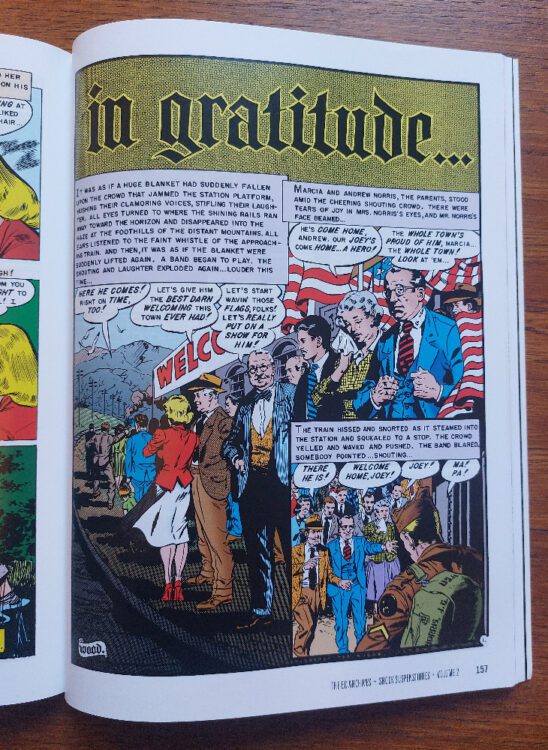
Published in Shock SuspenStories Vol 2 by Dark Horse Books
Comic Number 306: In Gratitude… (from Shock SuspenStories #11)
Something slightly different to end the week. Not entirely different, as it is EC again, but this comes from one of their moralistic stories, known affectionately as the “preachies,” and is a story that has been written about in several academic papers and books. In Gratitude… was written by Bill Gaines and Al Feldstein (as so many were) and illustrated by Wally Wood. The story follows Joey, a G.I. returning home from the Korean war after losing his arm in a grenade attack. His friend and fellow soldier, Hank, leapt onto the grenade saving Joey’s life but losing his own. Back at home Joey decides to go and visit Hank’s grave but this is where his world begins to unravel.
In Gratitude… is a story about racism. Hank was black, a fact hidden in the narrative until the final page (although you can guess that’s the twist fairly quickly) and the story contrasts the treatment Joey receives on returning home with the way that Hank’s body is treated. Hank has no family so Joey asks his parents to have him buried in their family plot. However, once the town discover that Hank was black, they bully the family into choosing a different burial place. In the end, at a celebration put on by the town for Joey, the soldier stands in front of his peers and expresses his disgust at the way his friend, and fellow war hero, has been treated in death. The story ends with the town silently creeping out of the town hall, leaving Joey alone and in tears.
There is an element of subterfuge both in the narrative and the comic. Hank’s identity is hidden in shadows and smoke during the flashback sequences so that there is no way to see his skin color. And the story as a whole is disguised in a similar way because it looks exactly the same as the other stories in the comic. The same structure, similar layouts, and the same presentation as any of the other horror or crime stories that EC put out. But this one carries with it a very strong message, and not one that readers would have often seen in comics in the 1950s.
It is a bold story and a bold statement by the editorial staff at EC. They proved they were willing to tackle difficult subjects and stand up for what they believed in. They didn’t do it very often, but when they did, they produced some outstanding stories. For an in depth look in to ECs “preachies,” I would recommend the book EC Comics: Race, Shock, and Social Protest by Qianna Whitted.
Join me next week for a slightly different post, looking at several different Frankenstein comics.

